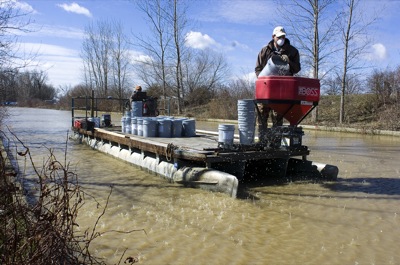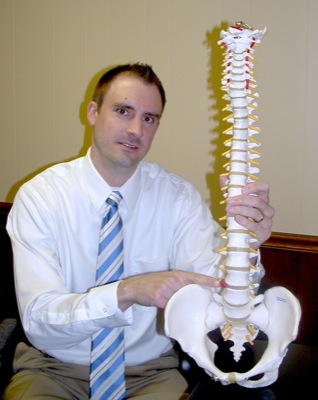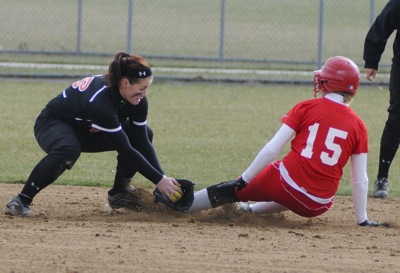Wednesday, April 6th, 2011
Testing phase begins
Alum added to lake; areas monitored for 30 days
By Nancy Allen

Photo by Mark Pummell/The Daily Standard
John Holz of HAB Aquatic Solutions, Lincoln, Neb., feeds a hopper with granular alum and broadcasts the pellets in a channel Tuesday at Kozy Marina. The state will continue the second alum pilot study until Friday to gather data for future large-scale alum treatments on the lake.
GRAND LAKE - Kozy Marina manager Ted Goodwin watched as pea-sized alum pellets were broadcast from the front of a pontoon and into the Grand Lake channel near his family's business on Tuesday.
Goodwin, and dozens of other business people, hope the alum does what it is supposed to do - keep away the algae and bring back people to the lake.
The marina channel is the first of three sites on the lake that will receive aluminum sulfate this week as part of a state-funded test. The alum's job is to inactivate phosphorous, the main food source of toxic blue-green algae that bloomed so severely last summer it nearly shut down the lake.
Goodwin said the business sold four boats this week, about which he is excited. But two years ago, before algae toxins caused the state to start issuing advisories warning people to stay away from the water, he'd have sold 12.
"We're hoping for a better year," Goodwin said. "With everything that's being put in place and the things that are going to happen, I believe it will be better."
The lagoon at the state park campground was to be pretreated today with hydrogen peroxide and then dosed with liquid alum on Thursday. The east channel at Windy Point will receive a heavier dose of only liquid alum on Friday. The sites will be monitored for 30 days.
A first round of alum testing done last summer used liquid alum only and produced phosphorous reductions, but not as much as state officials had hoped. Those analyzing the results recommended the second test be done during cooler temperatures with a hydrogen peroxide pretreatment to help the alum work.
"We're most interested in the effectiveness of the hydrogen peroxide in preparation for this summer's whole lake treatment," Ohio Department of Natural Resources spokesman Scott Fletcher said from the site Tuesday. "The results from this second study will help build the body of information to get the dosing right for future years."
A whole lake treatment is set for May 16. Due to limited funding, the state will only apply about 18 percent of the alum needed to effectively treat the 13,500-acre lake. Officials hope it will be enough to limit algae blooms to the point that no advisories are issued or at least so people can boat safely.
The state is planning to pay for the treatment with a $5 million loan, which would not need to be repaid, from the Ohio EPA Water Pollution Control Loan Fund.
Ongoing, small-dosed alum treatments will be needed in the lake for some years until conservation fixes on the land start reducing phosphorous runoff into the lake. Alum is being used as a short-term solution.
Goodwin said lake residents are doing their part, too. Many have installed channel aeration systems that disrupt algae formation and help grow beneficial bacteria that eats organic matter. He plans to install a system at the marina this year and one at Kozy Kampground, another business his family owns.
"With people putting in their own systems, that's only going to help and multiply how much more quickly we can fix the lake," he said.
Goodwin said the community has to fix the lake.
"If we don't get this fixed, how are we going to pay for our schools if our property values go down and our real estate collections go down," Goodwin said. "It's a have to."

Photo by Mark Pummell/The Daily Standard
Pea-sized granular aluminum sulfate pellets were applied to a channel Tuesday at Kozy Marina.



